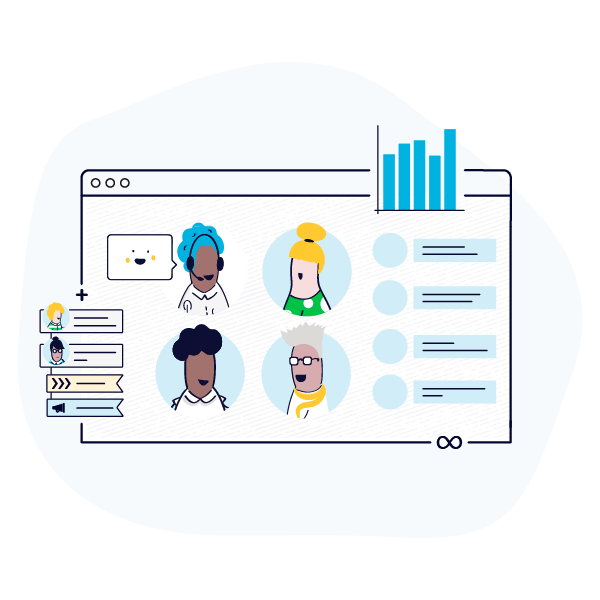
A common goal for marketers and customer relationship management (CRM) software users is to better understand their customers. This way, they can nurture more fruitful customer relationships and create more targeted marketing campaigns.
With customer data enrichment, all that and more is possible. CRMs collect customer data for a reason, and it’s up to you to use that valuable information for your company’s benefit.
Read on to learn more about customer data enrichment, how to collect customer data, and some major data enrichment benefits you can experience. Want to learn what an all-in-one CRM can do for you, too? Get in touch with Nutshell to start a free trial, or attend one of our live demos today.
Customer data enrichment is the process of enhancing a company’s existing customer information by merging it with data from external sources. This practice helps fill in missing details and creates a more complete and accurate profile for each contact. By enriching their data, businesses can improve lead scoring, achieve more precise customer segmentation, and deliver more personalized marketing and sales outreach.
Customer data enrichment is the process of taking individual customer data points and compiling and organizing them in a large database, like your Nutshell CRM, to reveal additional insights.
Rather than looking at customer data as individual pieces of information, data enrichment combines all that information and examines any overarching data trends or other key details that can help marketers gain a deeper understanding of their customers and their behaviors.
While both are essential data management processes, there is a distinct difference between customer data cleansing and customer data enrichment.
The purpose of customer data enrichment is to enhance your existing customer data. This typically involves organizing and analyzing data and adding to it from external sources relevant to the client and your business’s relationship with them.
On the other hand, customer data cleansing (or data cleaning) is the process of identifying and correcting errors within your data to ensure it’s accurate and consistent.
Data cleansing can include several activities, such as removing duplicate information, rectifying typos, updating information, and more.
Define your ideal customer and ProspectorIQ does the heavy lifting, so you can add new contacts to your CRM and start making more sales!

There are three major types of customer data marketers can collect with their CRM and use for customer data enrichment.
First-party data is information that’s collected straight from your audience. You can collect first-party data from website visitors, online form submissions like surveys and quote requests, email subscribers, and your CRM.
First-party customer data includes:
Second-party customer data is like evolved first-party data. Essentially, first-party data is shared with a trusted collaborator or partner. If you receive customer data from a business partner who collected it straight from their audience, that’s second-party data.
Second-party data includes information like names, emails, or basic demographic data and can be collected through methods like sweepstakes or giveaways where multiple companies are involved.
Third-party customer data is information collected by an entity separate from your own company. Some third-party data is publicly available to you, like census data, labor statistics, and information from other reputable research firms and government branches.
Third-party data can help you gain a deeper understanding of your customer base and flesh out the first-party data you’ve already collected. Third-party data includes:
With Nutshell’s all-in-one CRM system, customer data collection and enrichment are easy. Nutshell offers customizable forms to collect valuable customer data in whichever form works for you.
Edit the forms to allow for customer file uploads, multiple-choice options, description boxes, or any other data collection method you require. From there, Nutshell organizes that information so you can easily view customer data and create insightful customer profiles.
Nutshell’s reporting makes customer data enrichment easy. It offers options to track customer behavior, such as where customers enter your sales funnel, how they interact with your company, and what marketing efforts lead to conversions.

Customer data enrichment is a crucial practice all CRM owners should engage in. Here are just a few of the many data enrichment benefits you can profit from when you implement a strong enrichment strategy.
Besides being the primary goal, one of the benefits of customer data enrichment is gaining a better understanding of your customers. You’re not only getting basic information from them, like names, demographic data, and industries they work in, but you’re also collecting behavioral data.
You can’t necessarily collect behavioral data through forms, but you can use the information you collect from forms to find behavioral data.
For example, you may find that the majority of your leads are entering your sales funnel through social media ads and links. In that case, you can infer that your audience emphasizes social media usage. Then, you can direct your marketing efforts toward more actionable social media content and forms.
By better understanding your customer base, like their social media habits, interests, etc., you can create better customer experiences. In fact, creating a better customer experience should be your main priority, considering it’s one of the top consumer trends.
An improved customer experience helps foster better customer relationships and even encourages longer-lasting relationships.
These improved customer relationships can also lead to a better ROI with your marketing efforts. By understanding your audience through customer data enrichment, you can develop marketing campaigns with a higher chance of gaining customer conversions.
More targeted campaigns appeal better to consumers and are more likely to get them to act on calls to action (CTAs) because they feel personalized.
Personalized campaigns make customers feel you care about your audience as individuals and not just one big entity. Customers feel like you’re talking and appealing directly to them rather than shouting into the void that is your target audience.
Personalized campaigns are one of the biggest data enrichment benefits because they can continue to bring customers to your business long after they’ve been implemented. Personalized campaigns can lead to a better ROI for your company and better sales—that means more money for you! Who doesn’t want that?
Nutshell has what you’re looking for.

Your business’s customer data enrichment process may completely differ from another company’s. However, every data enrichment system should include a few core essentials.
It is a good idea to start with a clear outline of why and how you want to enrich your data. With this outline, you’ll be able to determine and gather precisely the type of information you need.
Consider the key data points that are most important to your business and organizational goals. Then, establish realistic benchmarks for your customer data, focusing on data accuracy, consistency, and comprehensiveness.
There’s no need to reinvent the wheel whenever your team works with your customer data. So, set up a system framework that allows you to repeat the process and easily adapt it when changes arise.
Incorporate the following when designing a solid framework:
Your business is growing, and with a capable data enrichment system in place, it’s bound to grow even more. To adapt to future changes as your business expands, you’ll need to ensure your customer data enrichment processes can scale with you.
Creating a scalable process comes down to selecting tools and solutions that can cope with your growing customer data volumes. Storage is a crucial factor in deciding which tools to work with, and opting for cost-effective cloud-based solutions may be the way to go.
Quality data is one of the most important factors to consider when creating an effective data enrichment process. Without a means to ensure the quality of your information, your customer data could end up harming instead of helping your business.
A few key best practices related to data quality include:
Gradual integration of a new data enrichment system is ideal for testing and refining your process before implementing it company-wide. Start with a smaller segment of your data or operation and expand slowly as you evaluate your enrichment results.
Put programs in place for pinpointing and tackling any issues that might arise, giving you the space and time to optimize as you go. Remember to gather as much internal and external feedback as possible when assessing your results to ensure your process refinement efforts pay off.
Collecting data comes with a great deal of responsibility, including keeping your customer’s information safe and secure. Find out about the laws and regulations related to data collection and privacy for your areas of operation.
Make sure your business complies with the relevant data privacy laws and obtains consent from customers and prospects before collecting and using their data. You should also employ robust data security measures to protect sensitive customer information.
Collecting and organizing customer data for enrichment may seem like a lot, but here at Nutshell, we’ve got your back. When you partner with Nutshell, you’re not just gaining access to our intuitive CRM. You’re gaining access to the CRM experts who can help interpret customer data.
Not convinced yet? See what all the hype is about by checking out one of our live demos or signing up for a free trial today.
Modern CRMs like Nutshell offer built-in enrichment features including PeopleIQ for contact data, VisitorIQ for website visitor identification, and ProspectorIQ for lead discovery. These tools automatically append job titles, company information, and social profiles to your contacts, eliminating manual data entry and keeping your CRM current.
Data enrichment costs vary widely based on your needs. Self-service tools typically charge per contact enriched (from
$0.10−$2 per record), while managed services range from $875−$5,975+ monthly depending on database size. Nutshell includes basic enrichment features in its CRM plans, with advanced Nutshell IQ capabilities available as an add-on.
A B2B software company enriches email addresses with company size and tech stack data to prioritize enterprise prospects. A manufacturing firm adds industry codes and revenue data to segment customers for targeted campaigns. Sales teams enrich LinkedIn profiles with direct phone numbers and decision-maker titles to personalize outreach and improve response rates.
Choose enrichment providers that source data legally through consent or legitimate interest. Prioritize first-party data collection, maintain transparent privacy policies, and ensure data processing agreements are in place. Always respect user rights to access and delete their data, and only enrich data for its original stated purpose to maintain compliance.
Data enrichment tools are self-service software you operate (like Nutshell’s PeopleIQ) that integrate with your CRM for on-demand enrichment. Data enrichment services are managed solutions where experts handle the entire process for you (like Nutshell’s WebFX-powered data enrichment services). Tools offer control and lower costs; services provide expertise and hands-off convenience.
Give our powerful, easy-to-use CRM a try for free for 14 days! Or join a live demo to see Nutshell at work!

Join 30,000+ other sales and marketing professionals. Subscribe to our Sell to Win newsletter!
